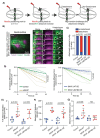This is a preprint.
SKAP binding to microtubules reduces friction at the kinetochore-microtubule interface and increases attachment stability under force
- PMID: 39149232
- PMCID: PMC11326240
- DOI: 10.1101/2024.08.08.607154
SKAP binding to microtubules reduces friction at the kinetochore-microtubule interface and increases attachment stability under force
Update in
-
SKAP binding to microtubules reduces friction at the kinetochore-microtubule interface and increases attachment stability under force.Curr Biol. 2025 Apr 21;35(8):1805-1815.e4. doi: 10.1016/j.cub.2025.03.003. Epub 2025 Mar 27. Curr Biol. 2025. PMID: 40154475
Abstract
The kinetochore links chromosomes to spindle microtubules to drive chromosome segregation at cell division. We recently uncovered that the kinetochore complex Astrin-SKAP, which binds microtubules, reduces rather than increases friction at the mammalian kinetochore-microtubule interface. How it does so is not known. Astrin-SKAP could affect how other kinetochore complexes bind microtubules, reducing their friction along microtubules, or it could itself bind microtubules with similar affinity but lower friction than other attachment factors. Using SKAP mutants unable to bind microtubules, live imaging and laser ablation, we show that SKAP's microtubule binding is essential for sister kinetochore coordination, force dissipation at the interface and attachment responsiveness to force changes. Further, we show that SKAP's microtubule binding is essential to prevent chromosome detachment under both spindle forces and microneedle-generated forces. Together, our findings indicate that SKAP's microtubule binding reduces kinetochore friction and increases attachment responsiveness and stability under force. We propose that having complexes with both high and low sliding friction on microtubules, making a mechanically heterogeneous interface, is key to maintaining robust attachments under force and thus accurate segregation.
Conflict of interest statement
DECLARATION OF INTEREST The authors declare no conflict of interest.
Figures





References
-
- Bayart E, Svetlizky I & Fineberg J (2016) Slippery but Tough: The Rapid Fracture of Lubricated Frictional Interfaces. Phys Rev Lett 116: 194301. - PubMed
-
- Cheeseman IM, Chappie JS, Wilson-Kubalek EM & Desai A (2006) The Conserved KMN Network Constitutes the Core Microtubule-Binding Site of the Kinetochore. Cell 127: 983–997 - PubMed
Publication types
Grants and funding
LinkOut - more resources
Full Text Sources
